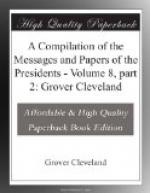Now it is maintained that all the streams and waters which have been named as flowing from the southern and eastern sides of this line are in the intended sense of the treaty of 1783 rivers which empty themselves into the Atlantic. The first argument adduced in support of this position is that the framers of that treaty, having, as is admitted, Mitchell’s map before them, speak only of two classes of rivers—those which discharge themselves into the St. Lawrence River and those which fall into the Atlantic Ocean; yet upon this map were distinctly seen the St. John and the Restigouche. The latter, indeed, figures twice—once as a tributary to the Bay of Miramichi and once as flowing to the Bay of Chaleurs.[58] It can not reasonably be pretended that men honestly engaged in framing an article to prevent “all disputes which might arise in future” should have intentionally passed over and left undefined these important rivers, when by the simplest phraseology they might have described them had they believed that in any future time a question could have arisen whether they were included in one or the other of the two classes of rivers they named. Had it been intended that the due north line should have stopped short of the St. John, the highlands must have been described as those which divide rivers which fall into the St. Lawrence and the St. John from those which fall into the Atlantic Ocean. The mouth of the St. Lawrence had been defined in the proclamation of 1763 by a line drawn from the river St. John (on the Labrador coast) to Cape Rozier. If, then, it had been intended that the meridian line should not have crossed the Restigouche, the phraseology must have been highlands which divide rivers which fall into the river and Gulf of St. Lawrence from those which fall into the Atlantic Ocean. Where such obvious modes of expressing either of these intentions existed, it is not to be believed that they would have been omitted; but had they been proposed to be introduced the American negotiators would have been compelled by their instructions to refuse them. Such expressions would have prescribed a boundary different not only in fact, but in terms, from that of the proclamation of 1763 and the contemporaneous commission to Governor Wilmot. Either, then, the British plenipotentiaries admitted the American claim to its utmost extent or they fraudulently assented to terms with the intention of founding upon them a claim to territory which if they had openly asked for must have been denied them. The character




